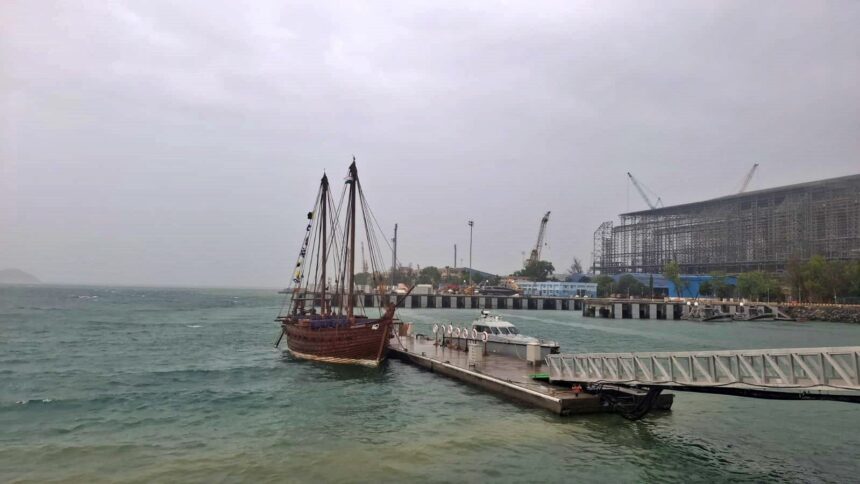The story goes that over 2,000 years ago, an Indian merchant vessel was sailing along the Mekong Delta (Southern Vietnam). On board was an Indian merchant, Kaundinya, and a crew of Indians. The ship came under attack from pirates, and while Kaundinya fought them off, the ship was damaged and had to be beached for repairs.
That’s when a local clan, led by warrior queen Soma, surrounded the crew. The Indian crew was outnumbered and faced certain defeat, even as Kaundinya bravely organised a defence. Their luck, however, turned when Soma fell in love with Kaundinya and proposed marriage. Consequently, the couple set up the kingdom of Funan.
On Wednesday, the Indian Navy inducted the Indian Naval Sailing Vessel (INSV) Kaundinya – the ‘stitched ship’ named after the legendary Indian mariner who sailed across the Indian Ocean to Southeast Asia – at the Naval Base in Karwar.
The ‘stitched ship’, modelled on a 5th Century ship depicted in a painting in the Ajanta caves, has been recreated using ancient stitching techniques and constructed by artisans and traditional shipwrights from Kerala using coconut fibre stitching, traditional wooden joinery, coir rope and natural resins and powered by cotton sails.
Sanjeev Sanyal, a member of the Prime Minister’s Economic Advisory Council who first pitched the idea of a stitched ship, said it has been named Kaundinya to pay homage to him.
“He is the first Indian mariner, who we know by name, to have crossed the seas to visit Southeast Asia and had a significant impact on world history,” Sanyal told .
“Though India has an old maritime culture dating back to the Bronze Age, we do not know the names of those mariners who were crossing the seas. The first definitive one, who was engaging in maritime voyages to far-away lands and of whom we know, is Kaundinya. His references are recorded in Cambodian and Southern Vietnamese sources, but not in Indian records. We do not know what Kaundinya’s ship looked like. But the ships of that period looked like what we have built,” he said.
Recounting the legend of Kaundinya’s voyage, Sanyal said, “Kaundinya and Soma set up a dynasty that went on to form the first Indianised Kingdom in what is now Cambodia/South Vietnam. This is corroborated by Chinese sources. All the future dynasties of the Khmer and Chams of Vietnam… to this day… trace their lineage to this marriage.”
The vessel, with a 15-member crew of the Indian Navy aboard, is expected to set sail on a historic voyage to Oman – retracing ancient trading routes – by the end of 2025. The project, which is part of an initiative to revive India’s rich maritime heritage, is being executed through a tripartite agreement between the Indian Navy, the Ministry of Culture and Goa-based shipbuilding company Hodi Innovations (OPC) Private Ltd.
“It was an idea which came out of a book,” Sanyal said. “We know that these stitched ships were used to cross the oceans from ancient times. There is enough evidence of Indians sailing from Gujarat to Oman and Bahrain, and all the way to Mesopotamia to carry out trade. So, we obviously knew how to make these ships,” he said.
“The problem is that there are no records of what exactly the seagoing ships during the Harappan period looked like. The earliest clear depiction of an ancient ship is really the Ajanta painting, which began as a sort of design to build around. Then there were some historical texts like Yuktikalpataru. We also used testimonies of ancient travellers from other countries who came to the Indian Ocean and mentioned seeing these stitched ships,” he said.
The Navy said the stitched ship incorporates several culturally significant features, evoking the rich maritime traditions of ancient India. Its sails display motifs of the ‘Gandabherunda’ – a two-headed eagle which was the royal insignia of the Kadamba dynasty who ruled the Konkan coast – and the Sun. The ship’s bow bears a ‘Simha Yali’ and a symbolic Harappan-style stone anchor adorns the deck.
The stitched ship features a main mast, mizzen mast and bowsprit mast, with steering controlled through steering oars. “It has trailing oars, square sails and a flexible hull. It does not have rudders. In modern sailing, usually, triangular sails are used. There are some advantages, but many disadvantages, because you have to basically sail with the wind. So, it is important to recognise that when we attempt to sail it, we will have to relearn the art of sailing with square sails,” Sanyal said.
Union Minister of Culture Gajendra Singh Shekhawat, the chief guest at the induction ceremony, said the launch of the vessel marked the resurgence of India’s maritime legacy, reaffirming our deep and enduring ties with the Indian Ocean world.








